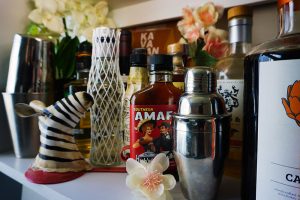The Art of the Bar Cart

Not going out to restaurants much these days, but still craving a fine cocktail from time to time? Perhaps you want to make cocktails for your lockdown pod. And now you’re staring at all those bottles left over from parties (oh, days of yore!) – they’re not much use, and a pox on whomever brought you mango-flavored rum. Time to get serious about stocking your liquor shelf.
When I first became serious about booze, I went gin-mad. I purchased bottles promising strange flavor profiles without so much as a sample, including one that was a radioactive shade of fluorescent yellow – I couldn’t resist the label, which promised the color came from “the post-distillation maceration of the rare botanicals.” I ordered cinchona online and learned to make my own tonic water (do it). I acquired a gin-infusion kit complete with dried juniper berries (don’t do it).
Meanwhile, my bar cart became unidimensional, and when I’d lure friends to visit by offering to make cocktails (using my fabulous collection), it didn’t always go well.
“But it’s all gin,” someone always observed with a tinge of dismay.
“No, it’s all different kinds of gin,” I’d reply, as if they were wrong.
“I don’t like gin,” another would assert.
“No, you just haven’t had the right gin,” I countered, still in correction mode.
Don’t be like me. Your crew might vote you out of the pandemic pod. Learn from my experience: If you’re ready to build a home liquor collection from scratch, here’s my recommended game plan.
The Big Five
Start with a bottle or two from “the big five:” vodka, whiskey, gin, tequila or rum. These can be consumed neat, or serve as the foundation for almost any cocktail. I vote you get one clear and one brown: gin and bourbon.
Salt and Pepper
Bitters are the salt and pepper of the cocktail world – a few dashes, and the recipe is complete. These tinctures are highly concentrated infusions of herbs and barks and other “secret” ingredients – and usually not tasty on their own. Everyone should have a bottle of angostura – a few dashes on a sugar cube dropped in a glass of champagne is “Breakfast-at-Tiffany’s” level of classic. Also, mandatory for an Old Fashioned.
Major Mixers
While the “big five” are A: drinkable alone, and B: the base of any cocktail, mixer booze is generally neither – but they are necessary to build a cocktail. The two most important in this category are vermouth (dry and sweet) and triple sec (orange liqueur). Get those. With the bourbon, sweet vermouth, and angostura, you’ve got a basic Manhattan cocktail (though you really need a maraschino cherry to top it off). P.S. If you get a really, really good vermouth, it’s worthy of savoring over ice on its own.
Lesser Mixers
These are the range of interesting liqueurs that frequently appear in cocktails and should go on your acquisition short-list: Luxardo (sour cherries, cherry pits and mystery ingredients), campari or aperol (bitter orange or less bitter orange), elderflower (there are lots of excellent competitors to St. Germaine these days), and chartreuse (made by monks out of a secret recipe of 130 herbs and botanicals). These will let you make Hemingways, negronis, Last Words and more (depending on your “big five” liquor).
Luxury Mixer Booze
This category is “luxury” because while these bottles are tempting and exotic, no one really needs them: the musk-melon-aloe-vera liqueur, the lavender-lily-of-the-valley, molasses-poppy. I once bought a jasmine liqueur, which I loved – but it’s so delicate that it would be lost in a cocktail. And how much jasmine juice can I drink straight? Be adventurous, by all means – but manage your expectations. It’s easy to go crazy in this category.
The Fridge
If you now have bottles from the first three categories above, you’re ready to start mixing. Cocktails like the negroni (gin, vermouth, campari) and the Manhattan (whiskey, sweet vermouth, angostura) require nothing but bottles. Obviously, if you want margaritas and the like, you’ll need fresh citrus (please don’t do all this work, only to use store-bought sour mix). But don’t be afraid to forage in your fridge for other things. Jams and jellies make extremely satisfying additions when you need some sweetness, and any kind of fermented product (e.g., kombucha, kimchi juice) is a tangy cocktail candidate. Remember that simple syrup is just equal parts sugar and water, gently boiled until it’s clear (grainy sugar is no fun in drinks).

